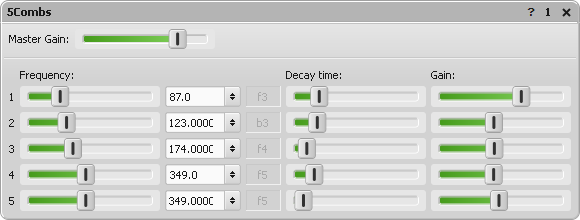| AudioMulch Help > Contraption Reference > Filters | Previous Next |
5Combs
Filters sounds through tuned comb filters that sound like resonating strings.

A comb filter is a very short delay line with feedback. The delay is usually so short that you can hear it resonating at a specific pitch. 5Combs is a bank of five comb filters in parallel. You can change the frequency, volume and decay time of each filter, as well as adjust the overall volume level of the combined signals.
 |
See the Adjusting Contraption Properties section for information about using sliders, knobs, presets etc. |
Related Contraptions
Parameters

Master Gain (InputGain) |
Controls the gain (level) of the overall output. |
Frequency (Frequency_1 - Frequency_5) |
Controls the fundamental frequency of each comb filter, ranging from 16Hz-12kHz. You can specify frequency with the slider. Or, you can choose the frequency by typing a value into the box at the right of the slider, or use the up/down arrows to select a value. You can also choose the note on a keyboard interface. To access the keyboard, click on the note name to the right of the frequency value box and the keyboard will appear. Click on a key to select a note. Note: The new frequency value is always displayed as a musical pitch name in the box at the right of the value box. When the frequency doesn't correspond exactly to a musical pitch, the distance from the exact pitch is shown in cents (+ means that the frequency is above the exact note frequency, and - means below). |
Decay time (DecayTime_1 - DecayTime_5) |
Determines how long each filter rings for, ranging from 0.02 of a second to 10 seconds. The actual decay time will be affected by the type of sound you use. |
Gain (Gain_1 - Gain_5) |
Controls the gain (level) of each comb filter. |
Relevant Example Files
The following files provide examples of how 5Combs can be used:
BeatProcess.amh, TranceRiffer.amh, MetaSSpatosaurus.amh & ResonantString.amh
 |
To open the Example Files directory, go to the File menu, select Open, and double-click on the Examples folder. Read descriptions of the example files here. |
Suggested Uses and Practical Applications
Andrew Bencina says: “By setting each filter to a different note, with moderate decay times it is possible to create a chordal drone by processing any signal, even those that originally seemed to possess no harmonic quality (e.g. Drums).”
Technical Discussion
As mentioned above, the comb filter is a very short delay line with feedback, with the delay so short that it appears to resonate at a specific pitch. This occurs as the result of periodic cancellation and reinforcement, which in turn creates a series of harmonically related peaks and notches throughout the audio frequency range. These peaks and notches are evenly spaced and of equal height and depth; when the frequency response is visualized it has the appearance of a comb, hence the name.
| Previous Next |
